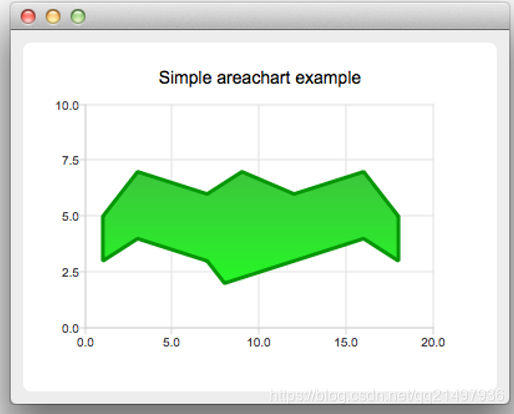Qt开发技术:QCharts(四)QChart面积图介绍、Demo以及代码详解
若该文为原创文章,未经允许不得转载
原博主博客地址:https://blog.csdn.net/qq21497936
原博主博客导航:https://blog.csdn.net/qq21497936/article/details/102478062
本文章博客地址:https://blog.csdn.net/qq21497936/article/details/108240696
各位读者,知识无穷而人力有穷,要么改需求,要么找专业人士,要么自己研究
红胖子(红模仿)的博文大全:开发技术集合(包含Qt实用技术、树莓派、三维、OpenCV、OpenGL、ffmpeg、OSG、单片机、软硬结合等等)持续更新中…(点击传送门)
上一篇:《Qt开发技术:QCharts(三)QCharts样条曲线图介绍、Demo以及代码详解》
下一篇: 敬请期待…
前言
红胖子,来也!
按照顺序,本章为面积图。
补充
QCharts所有的图表都依赖《Qt开发技术:QCharts(一)QCharts基本介绍以及图表框架详解》中的QChart、QChartView、QLegend、QValueAxis。
Demo


Demo下载地址
当前为v1.1.0版本
CSDN:https://download.csdn.net/download/qq21497936/12753524
QQ群:1047134658(点击“文件”搜索“qChartsTools”,群内与博文同步更新)
面积图
概述
面积图是使用QAreaSeries类或AreaSeries QML类型实现的。默认情况下,X轴被用作一个边界和QLineSeries或线列作为另一个。但是,可以使用QLineSeries或LineSeries作为两个边界。

QAreaSeries(面积图类)
概述
QAreaSeries类在面积图中显示数据。
面积序列用于显示定量数据。它是基于一系列线,用颜色强调边界线之间的区域。由于区域序列基于行序列,QAreaSeries构造函数需要一个QLineSeries实例,该实例定义区域的上边界。默认情况下,使用绘图区域底部作为下边界绘制面积图。下边界可以由另一条线指定,而不是绘图区域的底部。在这种情况下,QAReaSeries应该用两个QLineSeries实例初始化。
注意:当下边界值大于上边界值时,术语上下边界可能会产生误导。重点是这两条边界线之间的区域将被填充。

下面的代码片段说明了如何创建基本面积图:
_pLineSeries = new QLineSeries;
_pLineSeries2 = new QLineSeries;
_pLineSeries3 = new QLineSeries;
_pLineSeries4 = new QLineSeries;
// 方式一:逐一添加,大批量数据较慢
_pLineSeries->append(0, qrand()%11);
_pLineSeries->append(1, qrand()%11);
_pLineSeries->append(2, qrand()%11);
_pLineSeries->append(3, qrand()%11);
_pLineSeries->append(4, qrand()%11);
_pLineSeries->append(5, qrand()%11);
_pLineSeries->append(6, qrand()%11);
_pLineSeries->append(7, qrand()%11);
_pLineSeries->append(8, qrand()%11);
_pLineSeries->append(9, qrand()%11);
_pLineSeries->append(10, qrand()%11);
_pLineSeries->setName("通道1");
_pLineSeries->setPen(QPen(QColor(qrand()%256, qrand()%256, qrand()%256), 2));
// 通用:将数据插入到图表中
_pAreaSeries = new QAreaSeries();
_pAreaSeries->setName("面积1");
_pLineSeries->setPointsVisible(true);
_pLineSeries->setPointLabelsFormat("(@xPoint,@yPoint)");
_pAreaSeries->setUpperSeries(_pLineSeries);
_pChart->addSeries(_pAreaSeries);
效率更高的方式为:
// 方式二:逐一添加,大批量数据插入
QList<QLineSeries *> list;
list.append(_pLineSeries);
list.append(_pLineSeries2);
list.append(_pLineSeries3);
list.append(_pLineSeries4);
for(int index = 0; index < 4; index++)
{
QList<QPointF> listPointF;
for(int index = 0; index < 11; index++)
{
listPointF << QPointF(index, qrand()%11);
}
list.at(index)->append(listPointF);
list.at(index)->setName(QString("通道%1").arg(index+1));
list.at(index)->setPen(QPen(QColor(qrand()%256, qrand()%256, qrand()%256), 2));
}
// 通用:将数据插入到图表中
_pAreaSeries = new QAreaSeries();
_pAreaSeries->setName("面积1");
_pLineSeries->setPointsVisible(true);
_pLineSeries->setPointLabelsFormat("(@xPoint,@yPoint)");
_pAreaSeries->setUpperSeries(_pLineSeries);
_pChart->addSeries(_pAreaSeries);
_pAreaSeries2 = new QAreaSeries();
_pAreaSeries2->setName("面积2");
_pAreaSeries2->setUpperSeries(_pLineSeries2);
_pChart->addSeries(_pAreaSeries2);
_pAreaSeries3 = new QAreaSeries();
_pAreaSeries3->setName("面积3");
_pAreaSeries3->setUpperSeries(_pLineSeries3);
_pAreaSeries3->setLowerSeries(_pLineSeries2);
_pChart->addSeries(_pAreaSeries3);
_pAreaSeries4 = new QAreaSeries();
_pAreaSeries4->setName("面积4");
_pAreaSeries4->setUpperSeries(_pLineSeries4);
_pAreaSeries4->setLowerSeries(_pLineSeries3);
_pChart->addSeries(_pAreaSeries4);
Demo核心代码解析
建立QChart显示框架
AreaChartWidget::AreaChartWidget(QWidget *parent) :
QWidget(parent),
_pChartView(0),
_pChart(0),
_pXValueAxis(0),
_pYValueAxis(0),
_pLegend(0),
_pLineSeries(0),
_pLineSeries2(0),
_pLineSeries3(0),
_pLineSeries4(0),
_pAreaSeries(0),
_pAreaSeries2(0),
_pAreaSeries3(0),
_pAreaSeries4(0)
{
_pChartView = new QChartView(this);
_pChart = new QChart();
initData();
}
初始化数据
void AreaChartWidget::initData()
{
_pLineSeries = new QLineSeries;
_pLineSeries2 = new QLineSeries;
_pLineSeries3 = new QLineSeries;
_pLineSeries4 = new QLineSeries;
// 方式一:逐一添加,大批量数据较慢
_pLineSeries->append(0, qrand()%11);
_pLineSeries->append(1, qrand()%11);
_pLineSeries->append(2, qrand()%11);
_pLineSeries->append(3, qrand()%11);
_pLineSeries->append(4, qrand()%11);
_pLineSeries->append(5, qrand()%11);
_pLineSeries->append(6, qrand()%11);
_pLineSeries->append(7, qrand()%11);
_pLineSeries->append(8, qrand()%11);
_pLineSeries->append(9, qrand()%11);
_pLineSeries->append(10, qrand()%11);
_pLineSeries->setName("通道1");
_pLineSeries->setPen(QPen(QColor(qrand()%256, qrand()%256, qrand()%256), 2));
// 通用:将数据插入到图表中
_pAreaSeries = new QAreaSeries();
_pAreaSeries->setName("面积1");
_pLineSeries->setPointsVisible(true);
_pLineSeries->setPointLabelsFormat("(@xPoint,@yPoint)");
_pAreaSeries->setUpperSeries(_pLineSeries);
_pChart->addSeries(_pAreaSeries);
// 方式二:逐一添加,大批量数据插入
QList<QLineSeries *> list;
list.append(_pLineSeries);
list.append(_pLineSeries2);
list.append(_pLineSeries3);
list.append(_pLineSeries4);
for(int index = 1; index < 4; index++)
{
QList<QPointF> listPointF;
for(int index = 0; index < 11; index++)
{
listPointF << QPointF(index, qrand()%11);
}
list.at(index)->append(listPointF);
list.at(index)->setName(QString("通道%1").arg(index+1));
list.at(index)->setPen(QPen(QColor(qrand()%256, qrand()%256, qrand()%256), 2));
}
// 通用:将数据插入到图表中
_pAreaSeries2 = new QAreaSeries();
_pAreaSeries2->setName("面积2");
_pAreaSeries2->setUpperSeries(_pLineSeries2);
_pChart->addSeries(_pAreaSeries2);
_pAreaSeries3 = new QAreaSeries();
_pAreaSeries3->setName("面积3");
_pAreaSeries3->setUpperSeries(_pLineSeries3);
_pAreaSeries3->setLowerSeries(_pLineSeries2);
_pChart->addSeries(_pAreaSeries3);
_pAreaSeries4 = new QAreaSeries();
_pAreaSeries4->setName("面积4");
_pAreaSeries4->setUpperSeries(_pLineSeries4);
_pAreaSeries4->setLowerSeries(_pLineSeries3);
_pChart->addSeries(_pAreaSeries4);
// 通用:X轴和Y轴的处理(先插入数据再处理轴,否则不会有轴)
_pChart->createDefaultAxes();
_pYValueAxis = dynamic_cast<QValueAxis *>(_pChart->axisY());
// _pYValueAxis = new QValueAxis(_pChart);
_pYValueAxis->setRange(0, 10);
_pYValueAxis->setLinePen(QPen(Qt::black, 1));
// tick
_pYValueAxis->setTickCount(5);
_pYValueAxis->setGridLinePen(QPen(Qt::gray, 1));
_pYValueAxis->setGridLineVisible(true);
// subTick
_pYValueAxis->setMinorTickCount(4);
_pYValueAxis->setMinorGridLineVisible(true);
_pYValueAxis->setLabelFormat("%d");
// _pChart->addAxis(_pYValueAxis, Qt::AlignLeft);
_pXValueAxis = dynamic_cast<QValueAxis *>(_pChart->axisX());
// _pXValueAxis = new QValueAxis(_pChart);
_pXValueAxis->setRange(0, 10);
_pXValueAxis->setLinePen(QPen(Qt::black, 1));
// tick
_pXValueAxis->setTickCount(5);
_pXValueAxis->setGridLinePen(QPen(Qt::gray, 1));
_pXValueAxis->setGridLineVisible(true);
// subTick
_pXValueAxis->setMinorTickCount(4); // 相反
_pXValueAxis->setMinorGridLineVisible(true);
_pXValueAxis->setLabelFormat("%d s");
// _pChart->addAxis(_pXValueAxis, Qt::AlignBottom);
// 通用:视图显示设置为图表
_pChartView->setRubberBand(QChartView::NoRubberBand); // 不缩放
_pChartView->setDragMode(QChartView::NoDrag); // 拽拖:需要自己重写QCharView
_pChartView->setChart(_pChart);
// 标识
_pLegend = _pChart->legend();
_pLegend->setAlignment(Qt::AlignRight);
// 平滑
_pChartView->setRenderHint(QPainter::Antialiasing, true);
// 阴影
_pChart->setDropShadowEnabled(true);
}
设置数据线是否显示(标签显示会同步)
void AreaChartWidget::setDataVisible(int index, bool visible)
{
if(index < 0 || index > 3)
{
return;
}
QList<QAreaSeries *> list;
list.append(_pAreaSeries);
list.append(_pAreaSeries2);
list.append(_pAreaSeries3);
list.append(_pAreaSeries4);
list.at(index)->setVisible(visible);
}
设置主题样式
void AreaChartWidget::setTheme(QChart::ChartTheme theme)
{
_pChart->setTheme(theme);
}
设置动画模式
void AreaChartWidget::setAnimationOptions(QChart::AnimationOption option)
{
_pChart->setAnimationOptions(option);
}
设置标签显示位置
void AreaChartWidget::setAlignment(Qt::Alignment align)
{
_pLegend->setAlignment(align);
}
设置标签是否可见
void AreaChartWidget::setLegendVisible(bool visible)
{
_pLegend->setVisible(visible);
_pChartView->setRenderHint(QPainter::Antialiasing);
}
设置是否绘制平滑
void AreaChartWidget::setAntialiasing(bool antialiasing)
{
_pChartView->setRenderHint(QPainter::Antialiasing, antialiasing);
}
设置是否有阴影
void AreaChartWidget::setShadow(bool shadow)
{
_pChart->setDropShadowEnabled(shadow);
}
是否显示数据点(新增)
void AreaChartWidget::setPointVisible(bool visible)
{
_pAreaSeries->setPointsVisible(visible);
_pAreaSeries2->setPointsVisible(visible);
_pAreaSeries3->setPointsVisible(visible);
_pAreaSeries4->setPointsVisible(visible);
}
是否显示数据点坐标(新增)
void AreaChartWidget::setPointLabelVisible(bool visible)
{
_pAreaSeries->setPointLabelsFormat("(@xPoint,@yPoint)");
_pAreaSeries->setPointLabelsVisible(visible);
_pAreaSeries2->setPointLabelsFormat("(@xPoint,@yPoint)");
_pAreaSeries2->setPointLabelsVisible(visible);
_pAreaSeries3->setPointLabelsFormat("(@xPoint,@yPoint)");
_pAreaSeries3->setPointLabelsVisible(visible);
_pAreaSeries4->setPointLabelsFormat("(@xPoint,@yPoint)");
_pAreaSeries4->setPointLabelsVisible(visible);
}
重置随机数据
void AreaChartWidget::resetData()
{
_pChart->removeAllSeries();
_pLineSeries = new QLineSeries;
_pLineSeries2 = new QLineSeries;
_pLineSeries3 = new QLineSeries;
_pLineSeries4 = new QLineSeries;
QList<QLineSeries *> list;
list.append(_pLineSeries);
list.append(_pLineSeries2);
list.append(_pLineSeries3);
list.append(_pLineSeries4);
for(int index = 0; index < 4; index++)
{
QList<QPointF> listPointF;
for(int index = 0; index < 11; index++)
{
listPointF << QPointF(index, qrand()%11);
}
list.at(index)->append(listPointF);
list.at(index)->setName(QString("通道%1").arg(index+1));
list.at(index)->setPen(QPen(QColor(qrand()%256, qrand()%256, qrand()%256), 2));
}
_pAreaSeries = new QAreaSeries();
_pAreaSeries->setName("面积1");
_pAreaSeries->setUpperSeries(_pLineSeries);
_pAreaSeries2 = new QAreaSeries();
_pAreaSeries->setName("面积2");
_pAreaSeries2->setUpperSeries(_pLineSeries2);
_pChart->addSeries(_pAreaSeries2);
_pAreaSeries3 = new QAreaSeries();
_pAreaSeries3->setName("面积3");
_pAreaSeries3->setUpperSeries(_pLineSeries3);
_pAreaSeries3->setLowerSeries(_pLineSeries2);
_pChart->addSeries(_pAreaSeries3);
_pAreaSeries4 = new QAreaSeries();
_pAreaSeries4->setName("面积4");
_pAreaSeries4->setUpperSeries(_pLineSeries3);
_pAreaSeries4->setLowerSeries(_pLineSeries4);
_pChart->addSeries(_pAreaSeries4);
_pChart->addSeries(_pAreaSeries);
resetColor();
}
初始化颜色
void AreaChartWidget::resetColor()
{
QList<QLineSeries *> list;
list.append(_pLineSeries);
list.append(_pLineSeries2);
list.append(_pLineSeries3);
list.append(_pLineSeries4);
for(int index = 0; index < list.size(); index++)
{
list.at(index)->setColor(QColor(qrand()%256, qrand()%256, qrand()%256));
}
}
工程模板:对应版本号v1.1.0
对应版本号v1.1.0
增加面积图
对折线图、曲线图和面积图增加数据点显示、数据点标签显示
上一篇:《Qt开发技术:QCharts(三)QCharts样条曲线图介绍、Demo以及代码详解》
下一篇: 敬请期待…
Qt开发技术:QCharts(四)QChart面积图介绍、Demo以及代码详解的更多相关文章
- Qt开发技术:QCharts(三)QCharts样条曲线图介绍、Demo以及代码详解
若该文为原创文章,未经允许不得转载原博主博客地址:https://blog.csdn.net/qq21497936原博主博客导航:https://blog.csdn.net/qq21497936/ar ...
- Qt开发技术:Q3D图表开发笔记(三):Q3DSurface三维曲面图介绍、Demo以及代码详解
前言 qt提供了q3d进行三维开发,虽然这个框架没有得到大量运用也不是那么成功,性能上也有很大的欠缺,但是普通的点到为止的应用展示还是可以的. 其中就包括华丽绚烂的三维图表,数据量不大的时候是可 ...
- FFmpeg开发笔记(四):ffmpeg解码的基本流程详解
若该文为原创文章,未经允许不得转载原博主博客地址:https://blog.csdn.net/qq21497936原博主博客导航:https://blog.csdn.net/qq21497936/ar ...
- Qt开发技术:Q3D图表开发笔记(一):Q3DScatter三维散点图介绍、Demo以及代码详解
前言 qt提供了q3d进行三维开发,虽然这个框架没有得到大量运用也不是那么成功,性能上也有很大的欠缺,但是普通的点到为止的应用展示还是可以的. 其中就包括华丽绚烂的三维图表,数据量不大的时候是可 ...
- Qwt开发笔记(二):Qwt基础框架介绍、折线图介绍、折线图Demo以及代码详解
前言 QWT开发笔记系列整理集合,这是目前使用最为广泛的Qt图表类(Qt的QWidget代码方向只有QtCharts,Qwt,QCustomPlot),使用多年,系统性的整理,本系列旨在系统解说并 ...
- FFmpeg开发笔记(五):ffmpeg解码的基本流程详解(ffmpeg3新解码api)
若该文为原创文章,未经允许不得转载原博主博客地址:https://blog.csdn.net/qq21497936原博主博客导航:https://blog.csdn.net/qq21497936/ar ...
- Qt开发技术:图形视图框架(二)场景QGraphicsScene、QGraphicsItem与QGraphicsView详解
前话 Qt的图形视图框架,最核心的三个类为:QGraphicsScene.QGraphicsItem与QGraphicsView. 基于图形框架的高级白板软件Demo QGraphicsSce ...
- “全栈2019”Java第一百零四章:匿名内部类与外部成员互访详解
难度 初级 学习时间 10分钟 适合人群 零基础 开发语言 Java 开发环境 JDK v11 IntelliJ IDEA v2018.3 文章原文链接 "全栈2019"Java第 ...
- ARM Cortex-M底层技术(2)—启动代码详解
杂谈 工作了一天,脑袋比较乱.一直想把底层的知识写成一个系列,希望可以坚持下去.为什么要写底层的东西呢?首先,工作用到了这部分内容,最近和内部Flash打交道比较多,自然而然会接触到一些底层的东西:第 ...
- 【转】UML类图与类的关系详解
UML类图与类的关系详解 2011-04-21 来源:网络 在画类图的时候,理清类和类之间的关系是重点.类的关系有泛化(Generalization).实现(Realization).依赖(D ...
随机推荐
- [转帖]Linux fuse用户态文件系统及其libfuse
https://www.jianshu.com/p/abc5524ac18c 为什么要有用户态文件系统 VFS文件系统可知文件系统在内核态的,应用程序操作文件,统一调用内核态的VFS层抽象接口. 突然 ...
- [转帖]PostgreSQL 压测工具pgbench
1.命令 pgbench --help pgbench is a benchmarking tool for PostgreSQL. Usage: pgbench [OPTION]... [DBN ...
- [转帖]Redis 使用指南:深度解析 info 命令
https://www.cnblogs.com/hwpaas/p/9442410.html Redis 是一个使用 ANSI C 编写的开源.基于内存.可选持久性的键值对存储数据库,被广泛应用于大型 ...
- [转帖]记录自己安装内存带宽测试工具——Stream过程
测试环境: CPU:Kunpeng 920 8Core MEM:16G Storage:200G OS:openEuler 20.03 (LTS-SP3) 1 服务器资源监控工具--Stream 1. ...
- github-keydb 知识
https://github.com/Snapchat/KeyDB KeyDB is now a part of Snap Inc! Check out the announcement here R ...
- 银河麒麟(Ubuntu)无法上网问题的解决方法
最近部门借了几台银河麒麟的服务器. 因为有特殊用途, 不允许连接互联网,所以没办法只能搭建一个小的局域网进行处理. 但是发现在搭建过程中遇到了一些坑, 之前协助同事解决odoo问题时也遇到过, 当时本 ...
- ABP vNext系列文章04---DynamicClient动态代理
一.动态代理在ABP系统中的应用 1.它主要在做什么事件 之前开发系统想要在后台调用别的服务都是用HttpClient发起请求,在abp vnext中不需要我们这样做了, 你只要知道服务调用的接口方法 ...
- 多模态对比语言图像预训练CLIP:打破语言与视觉的界限
多模态对比语言图像预训练CLIP:打破语言与视觉的界限 一种基于多模态(图像.文本)对比训练的神经网络.它可以在给定图像的情况下,使用自然语言来预测最相关的文本片段,而无需为特定任务进行优化.CLIP ...
- Win32汇编:字符串浮点数运算过程
整理复习汇编语言的知识点,以前在学习<Intel汇编语言程序设计 - 第五版>时没有很认真的整理笔记,主要因为当时是以学习理解为目的没有整理的很详细,这次是我第三次阅读此书,每一次阅读都会 ...
- 使用Docker部署Tomcat
目录 使用Docker部署Tomcat 1. 获取镜像 2. 第一次启动tomcat 3.带参数启动 4.查看tomcat日志 5.时区问题 使用Docker部署Tomcat 1. 获取镜像 dock ...
